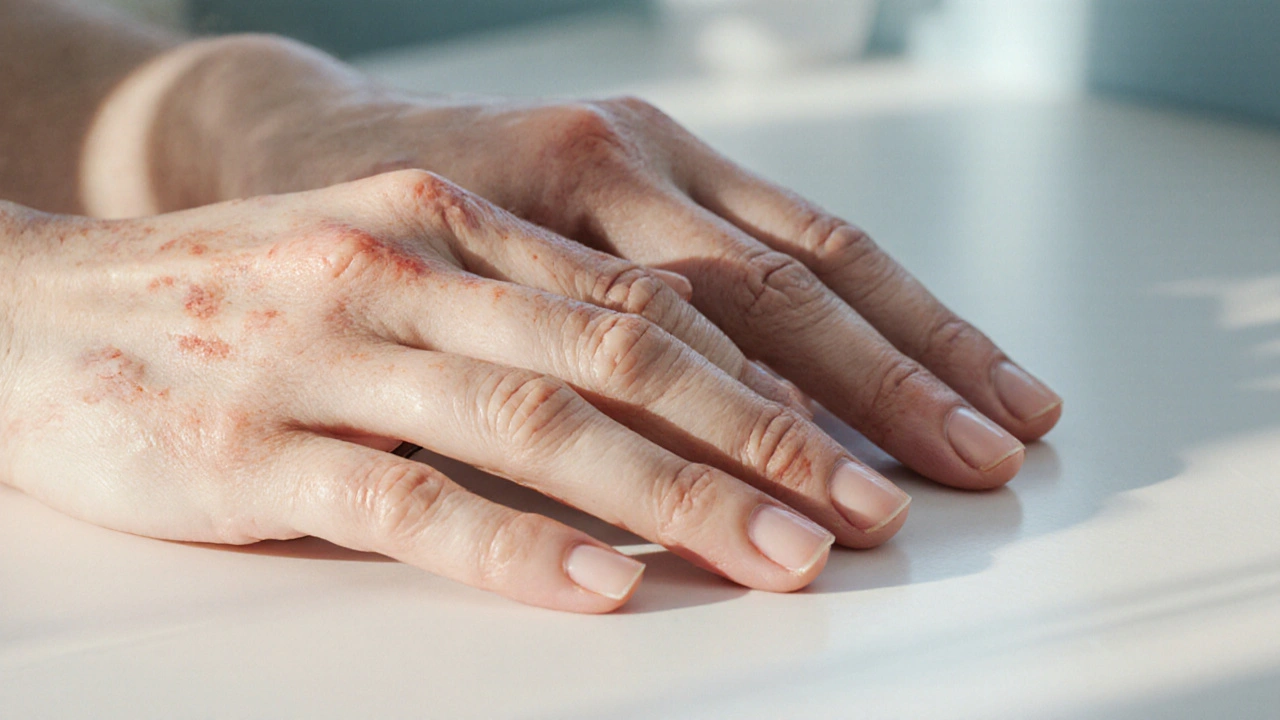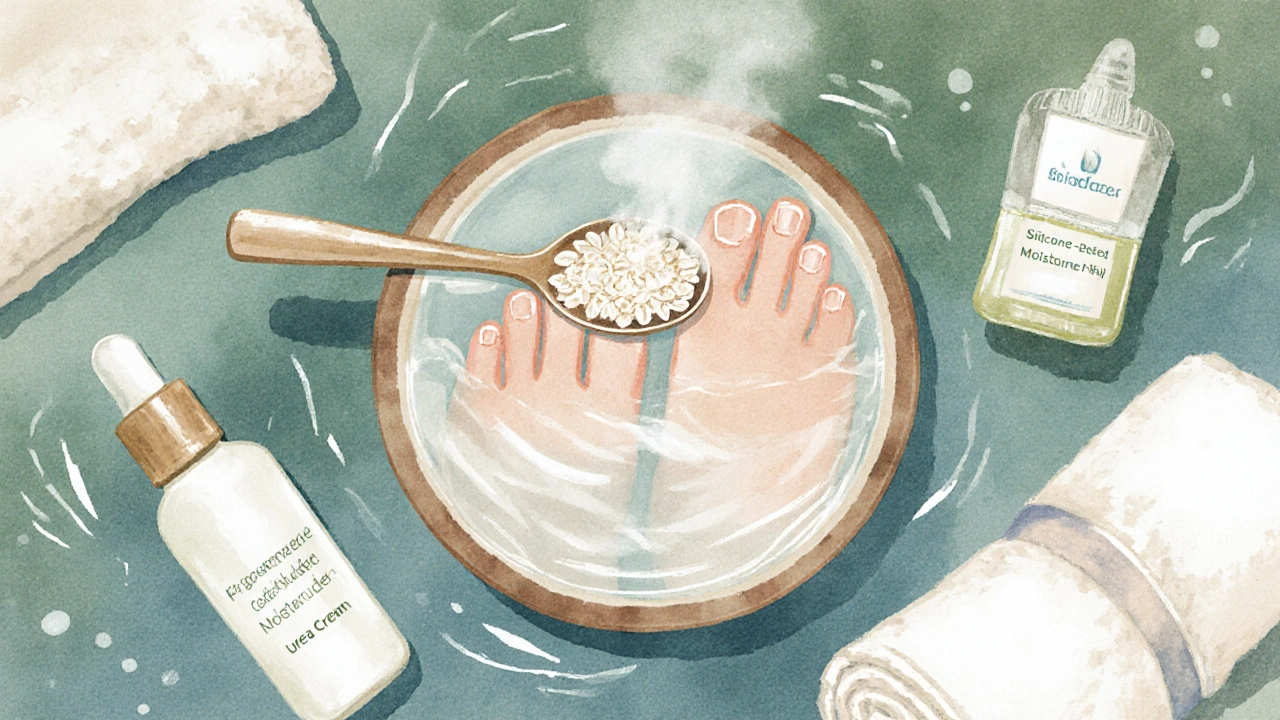Eczema Nail Care: Essential Tips for Healthy Hands & Feet

Eczema Nail Care Ingredient Checker
This tool helps identify whether common nail care ingredients are safe for eczema-prone skin. Check each ingredient below to see if it's generally safe or irritating.
| Ingredient | Safe for Eczema? | Why It Matters |
|---|
How to Use This Tool
Hover over any row to highlight it. Click "Check" to verify if an ingredient is safe for your eczema nail care routine. Remember to always patch test new products and consult a dermatologist for persistent issues.
Living with Eczema a chronic inflammatory skin condition that causes red, itchy, and dry patches can make even a simple manicure feel like a risky experiment. The skin around your nails is thin, prone to cracking, and especially sensitive to harsh chemicals. That’s why mastering eczema nail care is the fastest way to keep your hands and feet comfortable, looking decent, and infection‑free.
Understanding How Eczema Affects Your Nails
When eczema flares on the fingers or toes, the inflammation doesn’t stop at the skin surface. The nail matrix - the hidden tissue where the nail is formed - can become inflamed, leading to ridges, thinning, or even temporary nail loss. The cuticle, which protects the nail matrix, often dries out and splits, creating tiny entry points for bacteria and fungi. This is why you might notice white spots, pitting, or a yellowish tint after a flare. Recognising these signs early helps you intervene before a minor irritation turns into a painful infection.
Building a Gentle Nail Care Routine
Start with the basics: keep nails trimmed short and filed in one direction to avoid snagging. Use a soft, stainless‑steel nail clipper and a fine‑grit emery board. After trimming, soak your hands or feet in lukewarm water for 5-10 minutes - no hot tubs or boiling water, which can strip natural oils. Add a teaspoon of colloidal oatmeal or a pinch of baking soda to the water to soothe itching.
While your skin is still damp, gently pat it dry with a soft towel. Never rub aggressively; a gentle pat preserves the skin barrier and prevents micro‑tears. Immediately follow with a thick, fragrance‑free moisturizer (more on that below). This “wet‑wrap” method locks in moisture when the skin is most receptive.
Choosing the Right Products
Not every nail product is safe for eczema‑prone skin. Look for items labeled “hypoallergenic,” “fragrance‑free,” and “dye‑free.” Below is a quick comparison of common ingredients.
| Ingredient | Generally Safe | Why It Can Irritate |
|---|---|---|
| Petrolatum (Petroleum Jelly) | Yes | None - forms an occlusive barrier |
| Urea (10‑20%) | Yes | Higher concentrations can sting open skin |
| Fragrance (essential oil blends) | No | Can trigger allergic contact dermatitis |
| Formaldehyde‑releasing preservatives | No | Known sensitizers for eczema patients |
| Alcohol‑based nail polish removers | No | Dries out the cuticle and skin barrier |
| Silicone‑based cuticle oils | Yes (if fragrance‑free) | Rarely irritating; choose pure dimethicone blends |
For daily moisturising, a blend of petrolatum, ceramides, and a small amount of urea works wonders. Apply a thin layer after every wash and before bed. If you need a quick‑dry finish for short‑term use (e.g., before a meeting), choose a silicone‑based cuticle oil that doesn’t contain fragrance or alcohol.

Protecting Hands and Feet in Everyday Life
Even the best moisturiser won’t hold up against constant exposure to water, detergents, or abrasive surfaces. When you’re cleaning, gardening, or washing dishes, wear cotton‑lined nitrile gloves. The cotton lining absorbs sweat, while nitrile prevents the chemicals in soaps from reaching your skin. Change gloves at the first sign of dampness - a moist environment fuels bacterial growth.
At night, consider a light breathable covering like a hydrocolloid dressing on particularly cracked cuticles. It keeps the area moist and reduces the chance of infection while you sleep. A small humidifier in your bedroom (especially during winter) helps maintain ambient humidity above 40%, which lessens skin dryness.
When to Call a Professional
If you notice any of the following, it’s time to book an appointment with a Dermatologist a medical doctor who specializes in skin, hair, and nail disorders:
- Persistent redness, swelling, or pain around the nail despite gentle care.
- Yellow or green discharge - classic signs of bacterial or fungal infection.
- Rapid nail loss or abnormal thickening that interferes with daily tasks.
- Flare‑ups that don’t respond to over‑the‑counter moisturisers.
A dermatologist may prescribe a low‑potency topical corticosteroid or a calcineurin inhibitor (such as tacrolimus) to calm inflammation without thinning the skin as much as stronger steroids. In cases of fungal overgrowth, an antifungal cream containing terbinafine or clotrimazole will be recommended.
Quick Checklist & Common Mistakes to Avoid
- Trim nails straight across; avoid rounded edges that can catch on fabrics.
- Never use harsh nail polish removers with acetone or fragrance.
- Apply moisturiser within three minutes of drying your hands or feet.
- Use cotton‑lined gloves for any task involving prolonged water exposure.
- Check for signs of infection daily - early treatment stops spread.
By turning these habits into a routine, you’ll notice fewer flare‑ups, smoother cuticles, and nails that grow out looking healthier. Remember, eczema is a chronic condition, so consistency beats occasional heroics every time.
Frequently Asked Questions
Can I still use nail polish if I have eczema?
Yes, but choose a fragrance‑free, water‑based polish and apply a thin base coat of petrolatum first. Remove it with a gentle, non‑alcoholic remover. Limit wear to a few days and let your nails breathe in between.
Is it safe to file my nails with a metal buffer?
A fine‑grit (180‑240) buffer is fine if you use light strokes. Avoid aggressive filing, which can damage the nail plate and worsen eczema.
What ingredients should I look for in a moisturizer for eczema‑prone nails?
Ceramides, petrolatum, glycerin, and a low percentage of urea are ideal. They restore the lipid barrier without stinging.
Why do my cuticles crack during winter?
Cold air reduces ambient humidity, pulling moisture from the skin. Use a humidifier at night and apply a richer ointment before bed.
When is an antifungal cream necessary for nail issues?
If you see yellowing, thickening, and a foul smell, it’s likely a fungal infection (onychomycosis). A dermatologist can confirm and prescribe terbinafine or clotrimazole.
